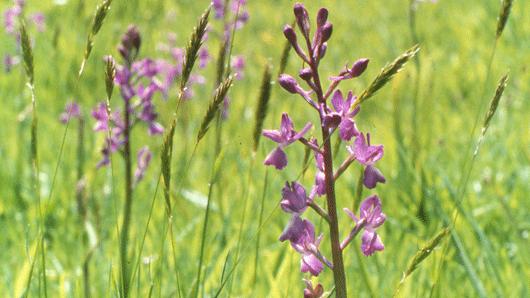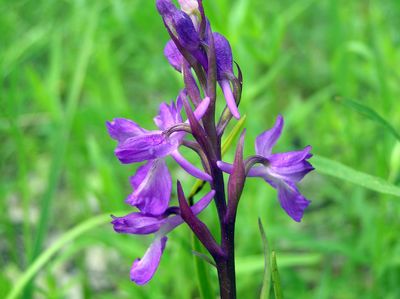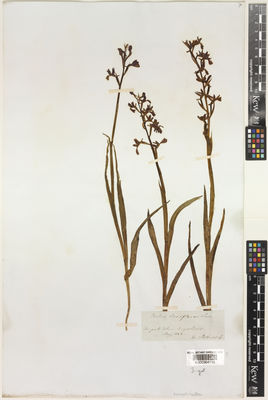Geography and distribution
Anacamptis laxiflora is native to western and southern Europe, where it is found from the Channel Islands southeastwards to Greece, Cyprus and Turkey.
Description
Overview: A terrestrial orchid with a loose spike of large, red-purple to violet flowers. It dies back during autumn and winter (dormant season), surviving as an underground tuber. It grows up to 1 m (but more commonly 30-80 cm) tall.
Leaves: Strap-like, green with no mottling, 10-15 cm long and 1-2 cm wide.
Flowers: Appear in March in southern Europe, and May to June further north. Arranged in a loose spike up to 25 cm long, comprising 6-20 individual flowers that are up to about 2.5 cm wide. The sepals are held upwards and backwards, whereas the two petals form a small helmet over the column. The lip has three lobes, the central one usually much shorter, and the side lobes are folded backwards. The middle of the lip is white or pale pink and sometimes has a few faint spots of darker pink. The spur is around 1 cm long and held horizontally or slightly upwards behind the flower.
Seeds: Numerous, tiny, dust-like, dispersed by the wind.
Jersey orchid is similar in appearance to Anacamptis palustris , and the two will hybridise where they grow together. However, this is relatively rare because they usually grow in different habitats.
Some authors recognise several subspecies on the basis of floral morphology and distribution. However, others argue that these populations are the result of hybridisation with A. palustris .
Threats and conservation
Although locally common across much of its range, Jersey orchid populations have suffered a decline due to modern agricultural practices, such as the draining and fertilising of damp pastures and hay meadows.
A number of sites on Jersey support good populations of Anacamptis laxiflora , and some are now managed with these orchids in mind by the Jersey National Trust. Wet meadow at the edge of the Rue de Pres wetland, for example, is managed by hay-cutting followed by grazing - a regime which has seen orchid numbers rise from 60 to 750.
In 1996, plants raised from wild-collected seed by Kew's Micropropagation Team were sent back to Jersey and re-introduced to the wild to bolster natural populations.
Uses
Jersey orchid is occasionally cultivated as an ornamental.
Millennium Seed Bank: Seed storage
The Millennium Seed Bank Partnership aims to save plant life worldwide, focusing on plants under threat and those of most use in the future. Seeds are dried, packaged and stored at a sub-zero temperature in our seed bank vault.
A collection of Anacamptis laxiflora seeds is held in Kew's Millennium Seed Bank based at Wakehurst in West Sussex.
Cultivation
Jersey orchid is one of the easier Anacamptis species to cultivate, although they can all be challenging. It can be naturalised in short turf in warmer parts of the south and west of the UK, as long as the soil does not dry out. The grass should be mowed, but only in late summer or early autumn, after the plants have flowered and set seed.
Anacamptis laxiflora can also be grown in pots in a cool greenhouse or alpine house, which is the best option for cooler parts of the UK. Tubers should be re-potted annually in late summer when the plants are dormant, using a compost mix containing three parts loam, three parts grit, two parts leaf mould and one part pine bark. The plants should be kept moist while they are in full growth, but kept drier when they are dormant - at which point the flower spike starts to die down.
Propagation is by seed or by separation of the new tuber.
This species at Kew
Jersey orchids can be seen growing in the turf in the Slips, below the Mansion at Wakehurst Place. These plants were part of a re-introduction trial. Grown in Kew's micropropagation laboratory, the first plants were planted out in the autumn of 1987.
Two years later, 35 flowering spikes were counted, and today there are hundreds, carefully managed by Wakehurst staff. The best time to see them is in May, when you may also see tongue orchid ( Serapias lingua ) and common spotted orchid ( Dactylorhiza fuchsia ).
Dried and spirit-preserved specimens of Anacamptis laxiflora are held in Kew's Herbarium where they are available to researchers by appointment. The details of some of these specimens, including images, can be seen online in Kew's Herbarium Catalogue.
Ground-breaking orchid propagation
Jersey orchid was the first terrestrial orchid species to be raised in Kew's micropropagation laboratory as part of the Sainsbury Orchid Conservation Project.
Growing terrestrial orchids from seed can be challenging because they often need a particular symbiotic fungal partner to germinate successfully. By inoculating the growth medium (agar) with a fungus found in a different orchid species, and by finding the correct growing conditions, the Kew staff cracked it!
After the plants were hardened off, a re-introduction trial was carried out at Wakehurst Place. This was successful, and the techniques developed with this relatively common species were then used for rare plants such as lady's slipper orchid ( Cypripedium calceolus ) and fen orchid ( Liparis loeselii ).
















